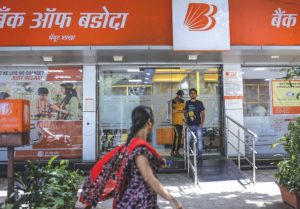 The Dena Bank, one of the worst performing PSBs, had been forbidden by the Reserve Bank of India from extending new credits under its stringent prompt corrective action (PCA). But it has now hopes for a revival and a fresh lease of life by the recent three-bank merger. With this deft move, the government has effortlessly shifted Dena Bank’s liabilities to two healthier banks, the Bank of Baroda and Vijaya Bank. The reasoning given is simple that the two strong banks will absorb a weak bank and create India’s third largest bank with much greater lending power.
The Dena Bank, one of the worst performing PSBs, had been forbidden by the Reserve Bank of India from extending new credits under its stringent prompt corrective action (PCA). But it has now hopes for a revival and a fresh lease of life by the recent three-bank merger. With this deft move, the government has effortlessly shifted Dena Bank’s liabilities to two healthier banks, the Bank of Baroda and Vijaya Bank. The reasoning given is simple that the two strong banks will absorb a weak bank and create India’s third largest bank with much greater lending power.
The Bank of Baroda, the largest among the three with total business of 10.3 lakh crore, is more than five times the size of Dena Bank — the weakest of the three with business of 1.73 lakh crore. Vijaya Bank, also smaller with business of 2.8 lakh crore, is, however, a relatively healthy bank. Bank of Baroda’s net NPA ratio is 5.4 per cent, Vijaya Bank’s is 4.1 per cent and Dena Bank’s is 11.04 per cent. The combined entity will have a net NPA ratio of 5.7 per cent.
Good on paper
On paper it seems a brilliant proposal but will it work? Will it give Dena Bank some oxygen to survive? Or it will sink even the healthy banks after the merge? We all know that the Dena got into trouble because of indiscriminate lending. It seems that the strategy is to ask healthy banks to take over weak banks to handle the bad loans crisis. The merger is part of the government’s efforts to consolidate the banking industry with an eye on overcoming the bad loan crisis. After the announcement of the merger, shares of healthy banks the Bank of Baroda and Vijaya Bank tanked at the stock exchanges, while Dena Bank gained sharply to hit upper circuit.
If the shareholders of Bank of Baroda, whose share fell by 16 per cent on news of merger, feel unhappy, that is understandable and not surprising at all. Dena Bank is the worst financial institution among the three entities and is currently under the Reserve Bank of India’s prompt corrective action framework. Unlike the other two banks, its shareholders are set to gain from being part of a new bank with greater financial strength and financial muscle. The current merger, it is worth noting, comes after the government let State Bank of India’s associate banks merge with their parent last year and the Life Insurance Corporation of India take over the troubled IDBI Bank this year.
Weaker entity
Forced mergers end up creating an entity that is weaker than the original pre-merger strong banks. There is no denying the fact that there are too many public sector banks in India and consolidation is a good idea on paper. However, the merger sends out rather poor signals.
We need to examine the current announcement of the government to merge Bank of Baroda, Vijaya Bank and Dena Bank in a continuing context of taking ad-hoc decisions without due consultation and value addition. Therefore, there is little wonder that the markets have reacted negatively to the decision.
The approach of the government has been to tuck a weak Dena Bank with a relatively strong Bank of Baroda and offer a lollipop of Vijaya Bank as a sweetener. At the end of it we have a relatively weaker structure. The Bank of Baroda has had a very comfortable capital position. It has just finished a process of clean up of all known NPAs. Vijaya Bank is one of the very few banks that continued to turn in profits when bank after public sector bank hit the red.
On positive side
On positive side, the Vijaya Bank has 52 per cent of its branches in the southern region while Bank of Baroda has only 10 per cent of its branches in South, thereby giving the amalgamated entity a better footprint. But what about Dena Bank which has many branches in Gujarat, where Bank of Baroda already has a very significant presence. Dena Bank also adds three years of losses, a business that is not growing, and a clutter of branches in areas where Bank of Baroda is already present.
In its hurry to contain the rising non-performing assets (NPAs), the government should not commit another blunder. It should professionally evaluate the State Bank of India experiment before proclaiming it as a universal solution. The net profit of SBI has dropped alarmingly after it was forced to absorb five of its associate banks besides the Bharatiya Mahila Bank. Similarly, the takeover of the ailing IDBI by LIC cannot be termed as a sound business decision.
There is nothing wrong in mergers and acquisitions (M&A) per se but these should happen purely on commercial considerations and must not be politically imposed. While PSBs are promoted by the government, they are run by their respective professional boards, which alone should take such decisions.
Future of banking reforms
And now we hear that the Bank of Baroda and Vijay Bank’s merger with Dena Bank could set the stage for further consolidations and mergers. All eyes will be on the proposed amalgamation to see how successfully the combination works.
The bank officials expect the merger to be completed in 4-6 months time, while banking industry veterans expect it would take at least one year to complete the amalgamation. Investors and bankers say that success of this exercise, is crucial for future such attempts. Improvement in operational efficiency is one positive that could emerge from the merger that is set to create the country’s third-largest lender.
The cost of funds for the merged entity is expected to come down since Vijaya Bank has a high dependence on short-term bulk deposits, which are typically high cost in nature. Ultimately, how well the three banks combine could well end up determining the future of consolidation among public sector banks. And it will open up more proposals coming up for mergers and acquisitions in public sector banks, financial institutions and other public sector enterprises which are loaded with surplus manpower, indiscriminate lending and brazen decisions sometime because political whims and fancies.
letters@tehelka.com













